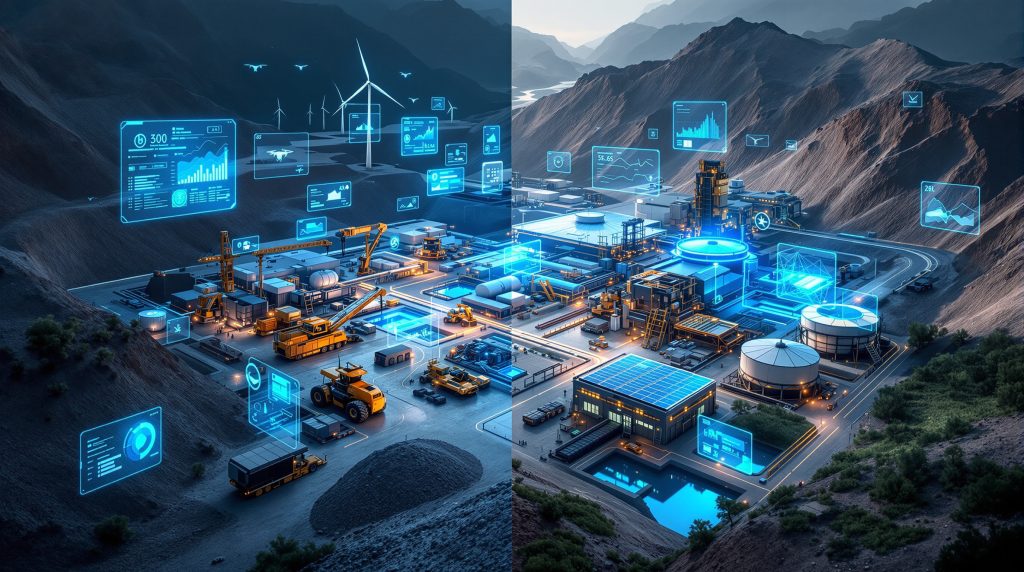Mine of the Future Initiatives: Transforming the Mining Industry
The mining sector is undergoing a profound transformation through innovative Mine of the Future initiatives. These forward-thinking programs are reimagining traditional mining practices by integrating cutting-edge technologies, sustainable approaches, and strategic investments to create a more efficient, environmentally responsible, and economically viable industry.
The Evolution of Modern Mining
The traditional mining landscape is rapidly evolving from conventional extraction methods to technology-driven operations. This transformation represents a fundamental shift in how mining companies approach resource development, with a strong emphasis on automation, artificial intelligence, and digital solutions.
Modern mining operations increasingly focus on reducing environmental footprints while maximizing resource recovery. According to the International Council on Mining and Metals (ICMM), mining companies adopting digital technologies can reduce unplanned downtime by up to 50%, significantly enhancing operational efficiency.
The global mining automation market, valued at $3.98 billion in 2022, is projected to reach $8.42 billion by 2030, growing at a CAGR of 9.8% according to Fortune Business Insights (2023). This remarkable growth reflects the industry's commitment to mining innovation trends.
What Major Government Programs Are Driving Mining Innovation?
US Department of Energy's Strategic Initiatives
The US Department of Energy's (DOE) Office of Fossil Energy has established significant programs to advance domestic mining capabilities. These initiatives focus on developing and implementing cutting-edge mining technologies to strengthen America's critical mineral supply chain.
The DOE has announced plans for Mining Technology Proving Grounds to support and accelerate innovative technology development and commercialization. These proving grounds will serve as real-world testing sites for next-generation mining technologies, creating collaborative partnerships between government, industry, and academia.
Additionally, the DOE has directed funding for National Laboratories to conduct critical research, development, and demonstration activities to advance strategies for strengthening domestic critical mineral supply chains. These initiatives highlight the government's commitment to revitalizing the US mining sector.
Critical Minerals Focus
The US Geological Survey identifies 50 mineral commodities as critical minerals transition to US economic and national security (USGS, 2022). This focus on critical minerals is particularly significant considering that the US imported more than 50% of its supply for 47 mineral commodities in 2021 (USGS, 2022).
The National Mining Association emphasizes that expanding domestic mining capacity is crucial for both national security and economic competitiveness, particularly for minerals used in renewable energy technologies and defense applications.
How Will These Initiatives Strengthen Domestic Critical Mineral Supply Chains?
Strategic Focus on Resource Independence
Mine of the Future initiatives aim to reduce reliance on foreign mineral sources through comprehensive domestic capacity building. By developing secure supply chains for materials essential to advanced manufacturing, these programs are establishing the foundation for American leadership in mining technology and innovation.
The creation of resilient mineral sourcing networks resistant to international disruptions represents a key strategic priority. This approach is particularly important given the vulnerabilities exposed in global supply chains in recent years.
Critical Minerals Prioritization
These innovative mining programs target minerals essential for renewable energy technologies, focusing particularly on materials crucial for defense applications. The initiatives emphasize developing extraction methods for previously uneconomical deposits while improving recovery rates from existing mining operations.
The critical minerals market is projected to grow from $182 billion in 2022 to $334 billion by 2030, according to Allied Market Research (2023). This significant growth underscores the economic importance of developing domestic mineral resources through advanced technologies.
What Technological Innovations Are Transforming Mining Operations?
Mining Innovation Technologies
Modern mining operations are increasingly adopting precision drilling and blasting techniques that minimize waste and environmental impact. These advanced extraction methods rely on selective mining approaches that significantly reduce waste generation compared to traditional techniques.
Remote-controlled and autonomous mining equipment is revolutionizing operational safety and efficiency. Autonomous haul trucks can operate continuously and achieve fuel efficiency improvements of 10-15% compared to manually operated trucks (Caterpillar, 2023). Rio Tinto operates the world's first fully autonomous mine at its Pilbara iron ore operations in Australia, where autonomous trucks transport ore 24/7 without human operators.
Real-time geological modeling technologies enable optimized extraction by providing miners with precise information about ore bodies. This data-driven mining approach ensures that mining operations target the most valuable resources while minimizing environmental disturbance.
Beneficiation Advancements
Novel mineral processing techniques focus on pre-concentration technologies at mine sites, allowing for more efficient transportation and processing. Enhanced separation methods for complex ore bodies enable the extraction of valuable minerals from previously uneconomical deposits.
Modern beneficiation processes emphasize reduced water and energy consumption, addressing two of the most significant environmental impacts of traditional mining. These technologies also achieve higher recovery rates for valuable minerals, improving both economic and environmental outcomes.
| Technology Area | Key Innovations | Benefits |
|---|---|---|
| Extraction | Autonomous equipment, precision techniques | Improved safety, reduced waste |
| Processing | Advanced separation, pre-concentration | Higher recovery, lower environmental impact |
| In-situ Recovery | Non-invasive extraction, targeted recovery | Minimal surface disturbance, reduced water usage |
| Digital Solutions | AI monitoring, predictive maintenance | Operational efficiency, reduced downtime |
In-Situ Extraction Methods
Innovative non-invasive approaches like solution mining techniques are gaining traction for appropriate deposits. These methods offer significant environmental advantages by minimizing surface disturbance compared to conventional mining operations.
Biological leaching processes for metal recovery represent another frontier in sustainable mining technology. These processes use microorganisms to extract metals from ore, reducing the need for harsh chemicals and high-energy processes.
Integration of environmental monitoring systems with in-situ extraction ensures that these innovative approaches maintain high environmental standards throughout the mining lifecycle.
What Environmental Benefits Do Mine of the Future Initiatives Offer?
Sustainable Mining Practices
Precision mining techniques can reduce waste rock generation by 20-30% compared to conventional methods, according to the World Bank's Climate-Smart Mining initiative. This significant reduction in waste generation addresses one of the most visible environmental impacts of traditional mining.
Advanced water treatment systems can achieve 95%+ water recycling rates in mining operations (International Water Association, 2022). These closed-loop processing systems dramatically reduce freshwater consumption, a critical consideration in many mining regions facing water scarcity.
Energy efficiency improvements through innovative technologies and processes decrease the carbon footprint of mining operations. The International Energy Agency notes that sustainable mining practices are essential for meeting climate goals, as mining currently accounts for 4-7% of global greenhouse gas emissions.
Environmental Monitoring and Protection
Real-time environmental impact assessment capabilities enable proactive management of mining's environmental footprint. By continuously monitoring air and water quality, mining operations can identify and address potential issues before they become significant problems.
Integrated remediation planning from project inception ensures that environmental considerations are built into mining operations from the beginning, rather than addressed as an afterthought. This approach significantly improves environmental outcomes while potentially reducing overall remediation costs.
Advanced tailings management technologies address one of the most significant environmental risks in mining operations. These technologies include dewatering techniques, paste backfill, and filtered tailings storage that reduce the risk of tailings dam failures and minimize long-term environmental liabilities.
Comprehensive sustainable mine reclamation strategies ensure that mining lands are returned to productive use after extraction activities are complete. These strategies often incorporate progressive reclamation approaches that restore portions of mining sites while operations continue in other areas.
How Are Partnerships Accelerating Mining Innovation?
Collaborative Ecosystem Development
Public-private partnerships in mining R&D have increased by 40% since 2020 (OECD, 2023). These collaborations leverage shared research facilities and resources to accelerate technology development and implementation.
University-industry collaborations in mining research grew by 25% from 2019-2022 (National Science Foundation, 2023). The Colorado School of Mines reports that such collaborative research initiatives are accelerating the development of sustainable mining technologies by reducing the time from concept to commercial application.
Combined expertise across disciplines allows for innovative approaches that might not emerge from siloed research efforts. These collaborations bring together geologists, engineers, environmental scientists, and technology specialists to develop comprehensive solutions to mining challenges.
Technology Proving Grounds
Real-world testing environments for new mining technologies reduce implementation risks for innovative approaches. By allowing technologies to be tested under actual mining conditions, these proving grounds help bridge the gap between laboratory research and commercial application.
Demonstrating commercial viability of advanced methods is a key function of technology proving grounds. This demonstration effect can accelerate industry adoption of innovative technologies by providing clear evidence of their operational and economic benefits.
These platforms for continuous improvement and iteration enable technologies to be refined based on real-world experience. This iterative approach ensures that mining innovations are practical and effective when deployed at commercial scale.
What Workforce Development Strategies Support Mining's Future?
Next-Generation Mining Skills
The mining industry faces a projected shortage of 2.7 million skilled workers globally by 2030 (Deloitte Global Mining Survey, 2023). This workforce gap underscores the importance of comprehensive training programs focused on digital mining technologies.
Modern mining requires the development of cross-disciplinary expertise that spans traditional mining engineering, data science, environmental management, and automation technologies. Digital mining roles require 40% more technical skills than traditional mining positions (McKinsey Institute, 2022).
Integration of environmental management competencies ensures that mining professionals are equipped to implement sustainable practices throughout the mining lifecycle. This holistic approach to mining education creates professionals who understand both the technical and environmental aspects of modern mining operations.
Educational Partnerships
Specialized mining technology curricula at educational institutions prepare the next generation of mining professionals for the digitally-transformed industry. These programs often incorporate both traditional mining engineering principles and cutting-edge digital technologies.
Industry-supported research opportunities for students provide practical experience with innovative mining technologies. These experiences help bridge the gap between academic training and industry needs, producing graduates who are ready to contribute to modern mining operations.
Apprenticeship programs for hands-on technology experience provide a pathway for workers to develop the practical skills needed in modern mining operations. These programs are particularly important for ensuring that technical innovations can be effectively implemented and maintained.
Continuing education for existing mining professionals ensures that the current workforce can adapt to technological changes. These programs help experienced miners transition to new roles that leverage both their traditional mining knowledge and new technological skills.
What Are the Economic Implications of Mining Innovation?
Domestic Economic Benefits
Automated mining operations can reduce labor costs by 15-25% while improving safety (PwC Mine of the Future, 2022). These efficiency gains improve the economic viability of domestic mining operations, making them more competitive in global markets.
The development of exportable mining innovation expertise creates new economic opportunities beyond the direct value of mineral production. Countries that develop mining technology leadership can export both their innovations and expertise to global markets.
Reduced operational costs through technological efficiencies enhance the competitiveness of domestic mining operations in global mineral markets. These cost reductions can make previously marginal deposits economically viable, expanding the domestic mineral resource base.
According to the Brookings Institution, expanded domestic critical mineral production could create significant economic value while reducing supply chain vulnerabilities for strategic industries like renewable energy, defense, and advanced manufacturing.
Supply Chain Security
Decreased vulnerability to international supply disruptions is a key economic benefit of domestic mining innovation. By reducing dependence on imported minerals, countries can insulate strategic industries from geopolitical risks and market volatility.
Stabilized pricing for critical mineral resources supports downstream manufacturing industries that depend on reliable access to these materials. This price stability improves planning and investment decisions throughout the industrial supply chain.
Strategic positioning in emerging technology markets is enabled by secure access to critical minerals. Industries like electric vehicles, renewable energy, and advanced electronics require reliable supplies of specific minerals, making domestic production capabilities strategically valuable.
How Are Mine of the Future Initiatives Addressing Global Challenges?
Meeting Growing Mineral Demand
Developing technologies to access previously uneconomical deposits expands the global resource base for critical minerals. These technological innovations effectively increase the world's mineral reserves by making lower-grade or more complex deposits economically viable.
Improving recovery rates from existing operations maximizes the value obtained from current mining activities. Enhanced recovery technologies can extract valuable minerals from waste streams and tailings, reducing both environmental impact and the need for new mining operations.
Creating circular economy approaches for mineral recycling complements primary mining activities by recovering minerals from end-of-life products and industrial waste streams. These recycling initiatives reduce pressure on primary mineral sources while addressing waste management challenges.
Climate Change Considerations
Reducing the carbon footprint of mining operations is essential for addressing climate change concerns. Energy-efficient extraction and processing methods, coupled with renewable energy integration at mine sites, can significantly reduce the industry's greenhouse gas emissions.
Developing minerals essential for renewable energy technologies positions the mining industry as a critical enabler of the global energy transition. Minerals like lithium, cobalt, nickel, and rare earth elements are fundamental to solar panels, wind turbines, and battery storage systems.
Integrating climate resilience into mining infrastructure design ensures that operations can withstand the increased frequency and severity of extreme weather events associated with climate change. This resilience planning protects both operational continuity and environmental safety.
What Future Developments Can We Expect in Mining Innovation?
Emerging Technologies on the Horizon
Advanced robotics and automation are poised to enable fully autonomous mining operations in hazardous environments. These technologies will increase safety by removing human workers from dangerous conditions while maintaining or improving operational efficiency.
Swarm robotics for coordinated extraction activities represents a frontier in mining automation. These systems use multiple smaller robots working in concert, rather than larger individual machines, potentially offering more flexibility and resilience in complex mining environments.
Human-robot collaborative workforces will combine the judgment and adaptability of human workers with the precision and endurance of robotic systems. This collaboration will create new roles for mining professionals focused on supervising and coordinating automated systems.
Remote operation capabilities for extreme locations will enable mineral extraction in environments that are currently inaccessible or too dangerous for conventional mining. These capabilities could expand the global resource base by opening new frontiers for mineral exploration.
Digital Transformation Acceleration
Comprehensive digital twins provide complete virtual representations of mining operations. These sophisticated models enable predictive modeling for operational optimization, allowing mining companies to test different approaches virtually before implementing them in the physical mine.
Scenario testing for environmental impact assessment helps mining companies minimize their environmental footprint by identifying the most sustainable operational approaches. These digital models can simulate environmental outcomes over decades, informing long-term planning decisions.
Real-time decision support systems integrate data from throughout the mining operation to provide operators and managers with actionable insights. These systems enhance operational efficiency while improving safety and environmental performance.
Sustainable Mining Evolution
Circular resource models integrate waste streams into valuable products, transforming what was once considered waste into economic opportunities. These approaches reduce environmental impact while creating additional revenue streams from mining operations.
Concurrent mine site remediation represents a paradigm shift from traditional approaches where remediation occurs only after mining is complete. By incorporating remediation into ongoing operations, this approach reduces overall environmental impact and final closure costs.
Energy-positive mining through renewable integration aims to transform mines from energy consumers to energy producers. By developing renewable energy resources at mine sites, companies can reduce operational costs while contributing to the clean energy transition.
Water-neutral processing through advanced recycling technologies addresses one of mining's most significant environmental challenges. By minimizing freshwater consumption and preventing water contamination, these approaches dramatically improve mining's environmental performance.
Frequently Asked Questions About Mine of the Future Initiatives
What are the primary goals of Mine of the Future programs?
Mine of the Future initiatives aim to transform mining practices through technological innovation, enhance domestic mineral security, reduce environmental impacts, improve operational efficiency, and develop a skilled mining workforce for next-generation operations. By integrating cutting-edge technologies with sustainable practices, these programs seek to create a mining industry that is both economically viable and environmentally responsible.
How do these initiatives benefit local communities?
These programs create high-quality employment opportunities in mining regions, often in rural areas where such opportunities may be limited. The focus on reducing environmental impacts benefits surrounding communities through improved air and water quality and reduced land disturbance.
Educational partnerships established through these initiatives provide workforce development opportunities for community members, preparing them for careers in the transformed mining industry. The economic benefits of sustainable mining operations strengthen local economies through direct employment, supply chain opportunities, and tax revenues.
What timeline can we expect for implementation of these technologies?
Many mining technologies are already being deployed at pilot scales, with broader commercial implementation expected over the next 3-5 years. The proving grounds approach is designed to accelerate this timeline by providing real-world testing environments that reduce implementation risks.
Implementation timelines vary significantly by technology type, with some innovations like autonomous equipment already achieving commercial scale while others like in-situ recovery methods may require longer development periods. The pace of implementation is also influenced by regulatory frameworks, which continue to evolve to address new technologies.
How do these initiatives address environmental concerns about mining?
Mine of the Future programs specifically target environmental improvements through reduced land disturbance using precision mining techniques. Technologies that enable lower water and energy consumption address two of mining's most significant environmental impacts.
Decreased waste generation through selective mining and improved processing efficiency reduces the volume of material requiring long-term management. Comprehensive monitoring systems enable proactive environmental management by providing real-time data on environmental performance.
The Transformative Potential of Mining Innovation
Mine of the Future initiatives represent a pivotal moment in the evolution of the mining industry. By combining strategic government investment, technological innovation, environmental responsibility, and workforce development, these programs are creating the foundation for a mining sector that can meet growing global mineral demands while addressing critical sustainability challenges.
As these initiatives progress, we can expect a mining industry dramatically different from its historical predecessors—one characterized by precision, efficiency, minimal environmental impact, and integration with broader economic and environmental goals. The transformation underway will not only strengthen domestic mineral security but also position innovative mining nations as leaders in sustainable resource development essential for modern economies.
The convergence of digital technologies, automation, and sustainable practices is creating unprecedented opportunities to reimagine mining operations. From autonomous equipment to real-time environmental monitoring, these innovations are addressing longstanding challenges while opening new possibilities for responsible resource development.
The mining industry's transformation through Mine of the Future initiatives demonstrates how traditional extractive industries can evolve to meet 21st-century challenges. By embracing innovation and sustainability, including AI exploration benefits, the mining sector is positioning itself as an essential contributor to the clean energy transition and technological advancement.
Looking to Spot the Next Major Mineral Discovery?
Discovery Alert's proprietary Discovery IQ model instantly notifies investors about significant ASX mineral discoveries, turning complex data into actionable opportunities for both short-term traders and long-term investors. Explore how historic discoveries have generated substantial returns by visiting the Discovery Alert discoveries page and position yourself ahead of the market.




